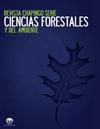Effective protocol to increase the percentage of grafting success of Pinus greggii Engelm. var. australis Donahue et López
IF 0.6
4区 农林科学
Q3 Agricultural and Biological Sciences
Revista Chapingo Serie Ciencias Forestales Y Del Ambiente
Pub Date : 2022-04-30
DOI:10.5154/r.rchscfa.2021.03.014
引用次数: 2
Abstract
Introduction: Grafted plants of conifers are used in the establishment of clonal seed orchards, but with the methodology currently used, unsatisfactory results are reported. Objective: To compare grafting and growth of Pinus greggii var. australis scion from nursery and field stock plants grafted on four rootstocks. Materials and methods: Scions of P. greggii Engelm. var. australis Donahue et López, collected from nursery stock plants (NSSP) and field trees (FSSP), were divided into terminal bud and basal segment, and grafted onto P. greggii var. australis, P. patula Schiede ex Schltdl. et Cham., P. teocote Schiede ex Schltdl. et Cham. and P. leiophylla Schiede ex Schltdl. et Cham. Percentage of grafting, height increment, diameter, scion-rootstock ratio and number of shoots (NS) were evaluated. Height and diameter increment data were subjected to an ANOVA and NS was analyzed with Poisson regression. Results and discussion: Grafting ranged from 93 to 100 %. The greatest increase in height was reported for P. teocote (14 cm) with scion from the terminal shoot of the nursery plant, while the combination P. greggii / P. leiophylla had the best scion-rootstock ratio with a value of 1. The highest NS was recorded with scion from the basal segment of NSSP. Getting two types of scions from one scion made the use of vegetative material more efficient. Conclusions: The use of nursery stock plants, 15-month-old rootstock, and two types of scions allowed having grafted plants in three months. The methodology developed was efficient, cost-effective and fast.提高葛松嫁接成功率的有效方案。多纳休和洛佩斯南方变种
简介:针叶树的嫁接植物被用于建立无性系种子园,但按照目前使用的方法,结果并不令人满意。目的:比较南方松(Pinus greggii var.australis)接穗在4种砧木上的嫁接和生长情况。材料和方法:P.greggii Engelm的Scions。从苗木植物(NSSP)和田间树木(FSSP)中采集的澳大利亚变种Donahue et López,将其分为顶芽和基部,并嫁接到P.greggii var.australis、P.patula Schiede ex Schltdl上。等人。,P.teocote Schiede ex Schltdl。et Cham。和P.leiophylla Schiede ex Schltdl。et Cham。对嫁接率、高度增量、直径、接穗砧木比例和芽数(NS)进行了评价。对高度和直径增量数据进行方差分析,并用泊松回归分析NS。结果与讨论:移植率为93~100%。据报道,具有来自苗圃顶芽的接穗的P.teocote(14cm)的高度增加最大,而P.greggii/P.leiphylla组合的接穗-砧木比最好,值为1。NSSP基部接穗的NS最高。从一个接穗中获得两种类型的接穗可以更有效地利用营养物质。结论:使用苗木、15个月大的砧木和两种类型的接穗可以在三个月内移植植物。所制定的方法高效、成本效益高、速度快。
本文章由计算机程序翻译,如有差异,请以英文原文为准。
求助全文
约1分钟内获得全文
求助全文
来源期刊
CiteScore
1.20
自引率
16.70%
发文量
0
审稿时长
>12 weeks
期刊介绍:
The Revista Chapingo Serie Ciencias Forestales y del Ambiente (RCHSCFA) is a scientific journal that aims to raise awareness of high-quality research products related to forest, arid, temperate and tropical environments in the world. Since its foundation in 1994, the RCHSCFA has served as a space for scientific dissemination and discussion at a national and international level among academics, researchers, undergraduate and graduate students, forest managers and public/private entities that are interested in the forest environment.
All content published in the journal first goes through a strict triple-blind review process and is published in the following formats: Scientific Articles, Review Articles, Methodologies, Technical or Technological Notes.

 求助内容:
求助内容: 应助结果提醒方式:
应助结果提醒方式:


